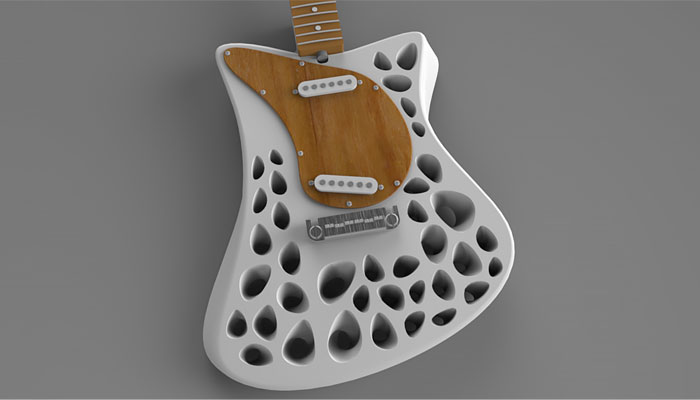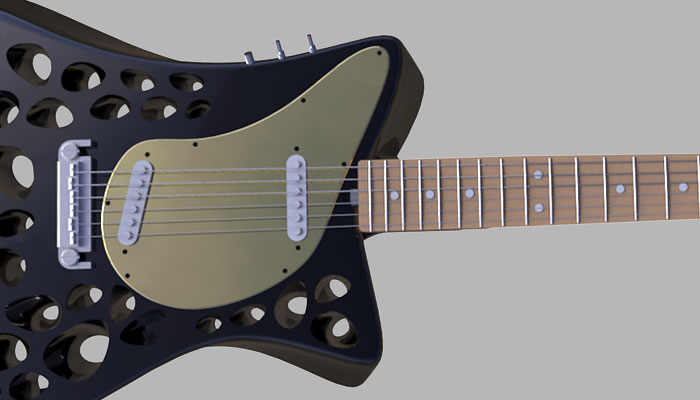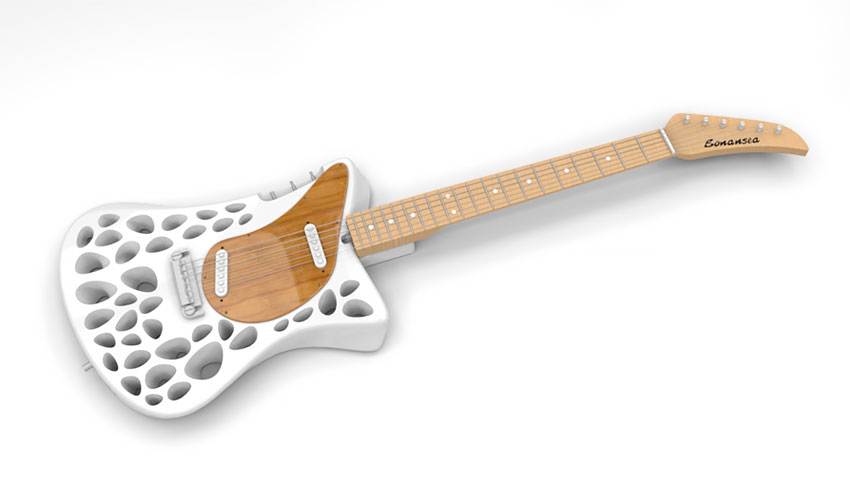Francisco Bonansea and his use of 3D printing to create guitars at home

Additive manufacturing is impacting all types of sectors, including music! We have witnessed the emergence of 3D printed instruments with the same sound capacity as a conventional musical instruments. This production method is becoming increasingly common among professional musicians and people from the maker community. For example, a few months ago we were delving into Nik Huber Guitars‘ use of 3D printing: making guitar bridges using amorphous metals, they obtaining the pieces more quickly and easily than with traditional methods. One of the projects that caught our attention comes from the Argentinian industrial designer, Francisco Bonansea, who is also using 3D printing to create his own line of guitars. Under the brand Bonansea, we met Francisco Bonansea to learn more about his activity and his relation with this manufacturing method.
3DN: Can you introduce yourself and tell us how your relationship with 3D printing began?
I am Francisco Bonansea Mazzoni, from Bahía Blanca (Bs As, Argentina). I am an industrial designer graduated from the Universidad Nacional de la Plata. Once I finished my studies, I started to work in a self-employed way, until I formed Fractal Design with a partner, and then I formed other partnerships and worked in different projects. I started to make my first impressions in 2016, in a local entrepreneurs’ club, making prototypes and mock-ups of designs, to then start making final products. Last year I concentrated more on this new facet, making drum accessories, guitar and bass stands.

3DN: What are the technical characteristics of the guitar you have developed?
The guitar has a headphone output to listen to yourself, or a speaker with the same 3.5mm audio cable. This allows you to use the guitar anywhere, either outside or inside a house, you can share the space with other people without disturbing them at all, giving the guitarist the flexibility to be able to practice and play in any circumstance. It weighs only 2 and a half kilos (one kilo less than one in the market); an important feature when playing in a show. It also contains a tone control (bass/treble), overdrive graduation, guitar and headphone volume.
3DN: Could you tell us the details of the guitar manufacturing process?
I started drawing with a pencil and paper, and then I went on to model it in three dimensions (x,y,z); taking into account the measurements of the components to be used (microphone, bridge, neck and electronics). With the defined design, I divided it into six parts, printing them in biodegradable PLA and then fitting the pieces together to form the body. Then I moved on to the part of assembling each of the components of the guitar. After this part, I closed the electronic part, with wooden covers so that it has a review towards the traditional guitar.
3DN: What is the biggest benefit that the additive manufacturing has brought you in this project?
The biggest benefit that this type of manufacturing gave me is the freedom to design what I want and materialize it from the comfort of my desk, using it also as part of the process to work with other materials such as steel, aluminum, wax, concrete, etc. from molds or 3D printed matrixes.

3DN: How do you see the use of 3D printing in the world of music?
I see that more and more products incorporating 3D printed pieces. Nowadays there are already people who are not involved in design or engineering who print objects without needing to 3D model them. In the future, not only will we be able to print instruments from our homes, but we will also be able to print our daily utensils, food, vitamins, and even scale the printing as boats, cars and even houses have already been made.
3DN: What future projects do you have in mind related to 3D printing?
As far as music is concerned, I plan to make different types of guitars, with different technological functions and make a family of products, including bass, cello, violin, electric double bass, etc. In addition to this I am involved in a project with a colleague, we want to give shape to the music, and generate a more fluid connection in the reading of the vibratory waves of the instruments.
I will also continue to develop products for everyday use, with the idea of developing all the products I can make, always faithful to my organic line of design, where I seek to generate a different reading in the products, in order to bring inspiration and optimism to people.
3DN: Any last words for our readers?
We are currently moving from programmed obsolescence to a stage that I find revolutionary. Today we can manufacture and/or repair objects or parts that break. Finally, I would like to encourage people to start getting involved in this world and become an increasingly self-sufficient society of individuals. If we could consume in a responsible way, being aware of all things that make up our waste, if we lived in a brotherhood and helped each other, I believe we could make the world a better place. You can find more info on Francisco’s LinkedIn.
What do you think of 3D printing in the music industry? What about the project from Francisco Bonansea? Let us know in a comment down below or on our Facebook and Twitter pages! Don’t forget to sign up for our free weekly Newsletter, with all the latest news in 3D printing delivered straight to your inbox!







